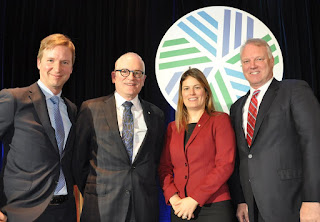Reporter Ed Mendel covered the California Capitol in Sacramento for nearly three decades, most recently for the San Diego Union-Tribune. More stories are at Calpensions.com.
CalPERS has asked four San Gabriel Valley cities that formed a job-training agency 40 years ago, the now-disbanded LA Works, to begin paying down an 18-month-old pension debt totaling $3.37 million.
A rejection of the request, for which replies were due last Friday, could lead to a 63 percent cut in the pensions of 62 retirees. CalPERS cut pensions for the first time last November, a 60 percent reduction for five former employees of Loyalton, a tiny Sierra town.
The CalPERS board was told last week that LA Works is an unusual problem. Under the CalPERS contract, only the disbanded joint powers authority is liable for the pension debt, not the founding cities of Covina, West Covina, Glendora, and Azusa.
“Whether or not they have a legal obligation, our view is they have a moral and ethical obligation,” Matthew Jacobs, CalPERS general counsel, told the board. “They’re the folks who put this thing together, and it’s their employees, essentially.
“And just like they need to take care of their own employees who happen to have been lucky enough to have worked directly for that city, they ought to be taking care of these folks who they have sent over to the JPA. That’s why we sent the letter.”
The joint powers authority, the East San Gabriel Valley Humans Services Consortium, doing business as LA Works, has not made a monthly payment to the California Public Employees Retirement System since June 2015.
“They are an inactive JPA, and they have basically closed their headquarters office, laid off their staff, and they lost their funding,” Arnita Paige, CalPERS contract management chief, told the board.
Los Angeles County supervisors voted in May 2014 to stop contracting with LA Works. Auditors found the consortium had overbilled the county by nearly $1 million for job training for jail inmates and the unemployed.
LA Works had submitted the low bid for a new contract, $32 million over six years, the Los Angeles Times reported. But after the audits the supervisors decided to give the contract to another bidder.
The consortium formed by the four cities in 1976 grew to have a staff of 125 with a $12 million annual budget while also representing Claremont, Diamond Bar, Irwindale, La Puente, La Verne, San Dimas and Walnut, a San Gabriel Valley Tribune editorial said in June 2014.
A “big part of the problem” was the chief executive, Salvador Velasquez, who had been with the agency since the beginning, said the Tribune. He was out of the country on vacation when audit questions arose.
“For pension reasons, he is technically retired and retained by the board as a consultant,” the Tribune said. “The board dragged its feet on finding a replacement who could have ferreted out the problems, which obviously were myriad.”
Velasquez received an annual pension of $120,777 in 2015, according to Transparent California, a website that lists the annual pay and pension of individual state and local government employees.
Another East San Gabriel Valley Human Services Consortium employee, Kathryn Ford, received a $100,240 pension. The other 42 listed pensions ranged from $51,919 to $1,832.
A CalPERS staff report said the consortium’s pension plan has 191 members — 62 retired, 36 transferred, and 93 separated. The annual pension debt payment expected next fiscal year is $365,419, but it’s a long-term commitment. A termination payment is $19.4 million.
CalPERS sent a final collection notice to the consortium last Nov. 1, followed by a final demand letter on Jan. 6, before sending a letter seeking payment from the four founding cities on Feb. 2, with a response date of Feb. 17.
“If payment is not received from East San Gabriel or the founding cities the next step is for CalPERS staff to recommend to the Board involuntary termination,” Brad Pacheco, CalPERS spokesman, said via email. “If the Board approved then benefits would be cut.”
The number of local government agencies that are falling behind on their monthly payments to CalPERS, mainly very small ones, is increasing during a decade-long phase in of a series of four rate hikes that began five years ago.
“Yes, we are starting to see more,” Paige replied last week when asked by board member Theresa Taylor if the number of monthly payment delinquencies is increasing.
Paige said she could not give the board the number of delinquent employers and contracts with joint power authorities, including those solely liable, but it’s being researched. CalPERS provides pensions for 3,000 local governments, nearly half of them school districts.
The historic decision to cut Loyalton pensions last November, coming nearly four years after the city stopped making monthly payments to CalPERS in March 2013, seemed to be a clear signal of a crackdown on unpaid pension bills, followed by new attention from the board.
In the first quarterly collections and termination report last week, the interim CalPERS chief financial officer, Marlene Timberlake D’Adamo, outlined a number of improvements, including a new “team approach” using members of several departments.
Copies of pay-up letters will be sent to employees, making them aware of the problem and giving them a chance to apply what pressure they can. Legislation may be proposed to shorten a one-year delay in contract termination.
To set a termination fee, CalPERS drops the earnings forecast used to discount future pension debt (now 7 percent) to a risk-free bond rate (now 2 percent), saying a lump sum large enough to pay all future pensions is needed because employer-employee contributions stop.
Several cities have considered leaving CalPERS (Villa Park, Pacific Grove, Canyon Lake) but did not due to the large fee. A federal judge in the Stockton Bankruptcy called the fee a “poison pill.” Others say of CalPERS: “You can check in, but you can’t check out.”
The report last week said four local governments left CalPERS, paying the termination fee to avoid pension cuts:
Citrus Pest Control District No. 2 of Riverside County, seven members, $447,041 termination fee; Newport Beach City Employee Federal Credit Union, six, $1,207,695; Metro Gold Line Foothill Extension Construction Authority, 23, $10,109,618, and San Diego Rural Fire Protection District, 40, $3,567,318.
Since February 2015, two local governments adopted resolutions to terminate contracts, Niland Sanitary District and Trinity County Waterworks District No. 1, and four sent a notice of intent to terminate: Alhambra Redevelopment Agency, California Redevelopment Association Foundation, Herald Fire Protection District, and Exposition Metro Line Construction Authority.
In the last four months, four delinquent local governments paid up and avoided termination, including the Central Sierra Planning Council.
At Loyalton, which faced a $1.7 million termination fee, Mayor Patricia Whitley was unavailable. But a city hall spokeswoman confirmed a report that the city, on a month-to-month basis, is paying retirees the amount of the 60 percent pension cut.


